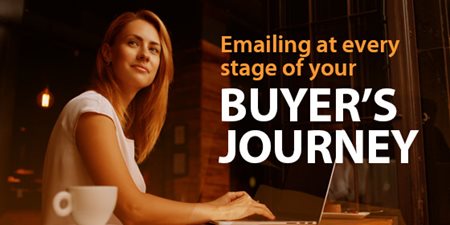Buyer’s Journey: How to Maximize Your Opportunities with Email
Understanding the journey your buyer undertakes every time they make a purchase is critical if you want to maximize your opportunities for sales. No matter what form of marketing you’re using, whether it’s social media, blog content, paid advertising, or in this case, email, each step of this journey is just as important as the last.

Email is renowned for being one of the greatest forms of marketing since you’re able to connect on a one-on-one basis with your customers, as well as being able to cover every step of the journey from directly within their inbox.
To help grasp and manipulate the power of email, we’re going to explore each step of your customer’s journey while detailing everything you need to know; ensuring you tick all the boxes and maximize your business’s chance for success.
Understanding the Buyer’s Journey
While the buyer’s journey could be broken down into an infinite number of steps, and each one will vary depending on your business and the way you approach sales, there are three main steps that every single business will have and are the most important aspects you’ll need to be thinking about.
These break down into; Awareness, Consideration, and Decision. Each one is reasonably self-explanatory, but so we’re all on the same page;
Awareness
This is the stage where your lead first becomes aware of the product or service you offer. In some cases, they may have a problem in their life; such as being unable to get to A to B by public transport or desiring a more luxurious car.
This is the part where the customer will come to the realization that they want or need something. In some cases, this stage may start when the customer becomes aware of what you’re offering, and you’ve grabbed their attention.
Consideration
Now that they’re aware of your product or service, the buyer will now go through the stage of thinking about whether they want to invest in the opportunity or not. In this section, they may read up on the product, look for recommendations from their friends, read reviews and testimonials, or search for influencers.
Other considerations such as price, shipping, availability, and need will all come under this step.
Decision
Once the buyer reaches a point where they can safely make the decision of whether they want to buy the product or service. They’ll take everything they’ve thought about in the last few steps, put it together and decide whether it’s worth buying the item for themselves.
“This form of buyer’s journey is usually demonstrated as a funnel with Awareness at the top. There are plenty of other steps that can be involved in this process; usually ‘interest’, ‘intent’, and ‘purchase’, but if you’re new to this technique, it’s easier and more direct to stick with three,” says Michelle Gooderham, an email marketer for Academized and StudentWritingServices.
Combining the Journey with Email
In the following sections, we’re going to explore the ins and outs of this journey and how you can use it in your email marketing efforts to maximize sales and, therefore, your business’s success.
Email & Awareness
As we stated above, the first step of the sales journey is to generate interest in your product or service by making your potential buyers (leads) aware of what you’re offering. You can do this in a catalog format which provides links and access to multiple products that you offer.
This is a great technique if you’re running a sales promotion which includes multiple products. Within the promotional email, you can make your customers aware of all the products that are included with quick links to each to make the sale far more likely.
However, if you’re planning on releasing a new product or service, a dedicated email for each product is a much better way to approach it. This is because you’ll have more space to detail information on the product.
When you’re selling a product, it’s important to remember that you’re not selling the features of your product, you’ll selling the benefits. If you’re selling a coat, you’re not selling it because it’s made of cotton and buttons, you’re selling it because it’s warm in cold weather and lasts a long time.
Benefits > Features
If your product addresses a certain problem like a blender makes eating a healthier diet easier, describe your product as a solution; not just as a costly product.
Email & Consideration
Now that you’ve got your lead thinking about your product and they’re interested in what you have to say, they’re going start looking for more reasons as to why they want to buy your product. Most notably, they’re going to look for social proof.
When you’re watching an online video, without even thinking about, you’ll naturally opt for videos that have more views and likes. This is because views are ‘social currency’ with what content is good and worth watching, and the same can be said for products and services.
If you go on Amazon, you’re far more likely to buy a product with loads of reviews than a product with none. In your emails, you need to make your lead’s life easier by posting reviews and testimonials from past customers.
Another great way to approach this is by sending out a case study. This could be of a previous customer who used your product for a 7-days or a month, and it changed their life. This is how workout and fitness-based memberships will sell their services effectively.
“Another fantastic approach is by offering a sample or demo of your product or service. Of course, this isn’t always possible, but offering a free eBook on the subject of your product, giving them access to a buyer guide, or linking content that relates to the product can be a great way to give your lead the boost they need to become a paying customer,” explains Nick Elves, a content manager for Top Canadian Writers.
Email & Decision
Once your lead is happy that they want to buy your product, you need to make this as easy and as safe as possible, once again giving them everything they need to have the best experience. For this, include a fast link to the product or service page from directly within the email.
Another great addition to have here is information about the payment system and security of your website. Having a Trust seal from a website like TrustPilot is a great way to prove that your company and website is safe and secure to buy from, making it far more likely your customer will be willing to make a purchase.
Once your customer has made the purchase, make sure you’re sending them follow-up emails that give them all the information they need to know on how to use the product, any information they need to know on shipping and returns, and how they can get in contact with you if they need any help.
Note
Since you’ll be writing a lot of emails throughout the sales journey, so increases the risk of mistakes and errors. If your content is full of mistakes and errors, your customers are going to be put off by your business, and they’ll be less likely to make a purchase.
Instead, you can use online services like Revieweal, Simple Grad and Let’s Go and Learn to help remove errors, structure your emails properly, and to make sure it’s the highest quality for your readers.
As you can see from the information above, the main thing you need to be thinking about when it comes to sending emails throughout your buyer’s journey is to ensure your lead has the best experience.
By giving them everything they need, they won’t have to worry about clicking out the email or going elsewhere, dramatically improving your chances of securing a genuine sale.

Grace Carter
Grace Carter is a content manager at Essayroo and Australian Help services. She curates content creation, editing and proofreading processes and also works side by side with the marketing team. Grace teaches creative writing at Academized writing website.